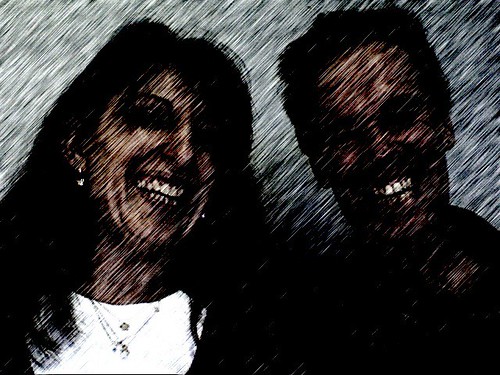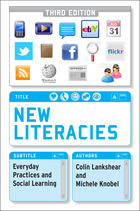Monday, July 14, 2008
Postmodern "Migrations": Literacy, Identity and Place
We're currently in session at the Mount Saint Vincent University's Masters of Literacy Summer Institute in Toronto. Colin is about to speak on matters of literacy, identity and place.
He opens by framing two moments in time tat exist about 30 years apart: Chris Searle's "Classrooms of Resistance" (1975) and Southpark's "Make Love not Warcraft" episode (2006). The theme on which he's focussing is on these two texts as "solidarity tales" that are to a large extent not only set in different times but are worlds apart.
Searle's approach engaged students in examining their immediate contexts within larger spheres with respect to living within a post-industrial town struggling at the time to reinvent itself.
Colin explains that for him, place is space that is imbued with meaning. Place in this sense impacts directly on our identities. You can imagine a dinosaur's skeleton--you can imagine it in a theme park, or you can imagine it as a museum. If you are in the theme park, the dinosaur is used as a playful ride, while if you are in the museum, the dinosaur skeleton becomes catalyst for learning and/or for thinking about history. In this example,it becomes clear how place shapes and informs and constructs one's identity (e.g., as a theme park player, as a learner etc.).
Colin then provides an overview of Chris Searle and his work with students in Sheffield, England, who actively built on social class identity in order to foster solidarity among his very diverse students. He was thoroughly engaged with the lcoal school community and aimed at getting his students to think about who they were in class terms, race/ethnicity terms, etc. and how the social system worked to enable some people to buy a half-million pound apartment in the gentrified docks area, while the students' own families in the area struggled to make ends meet.
Colin plays a clip from the "Make Love, Not Warcraft" from Southpark and gives a precis of the episode. He explains how he reads it as a solidarity tale--where a group of very diverse people (from the four Southpark lads, to Stan's dad, to the developers of the World of Warcraft--Blizzard) as they work together to defeat a rogue player who--in this episode of the show--threatened the very existence of the "World of Warcraft". He explains that this particular tale of solidarity is not built around issues of class or ethnicity, but around shared affinities. The place in this case is not a physical location, but virtual. The boys triumphed largely by engaging in menial game work by the incredibly tedious strategy of killing boars in order to "level up", whereas Searle's students read newspapers and watched documentary films as part of their solidarity work etc. Both are very different literacy practices. another difference was that the Southpark kids were the "leaders" and the agents, with the adults more or less falling in behind to solve the problem of the rogue plaer. In Searle's case, he was very much the leader with respect to helping stduents to analyse their own lives and identities.
Key changes
Colin then discusses key changes he sees having taken place in the past 30 years--and which he refers to as a "world of difference".
- technoclogical= digital electronics
- economic - "New Work Order"
- continuing global diasporas
- theorisation - rise of the "post" (the multiple)
- emergence of the "risk society" (Beck) within an intensified experience of "liquid modernity" (Bauman)
Changes over the past 30 years
Literacy is:
- no longer singular, but multiple
- no longer fixed, but now unstable
- no longer homogenous, but multimodal
- no logner linear, but non-linear
- physical and now also "cyber"
- analogue and now digital
- local scale, now also global scale
Place is:
- no longer singular, now multiple
- no longer fixed, now fluid
- no longer stable, now shifting
- not just physical, now also "cyber"
- not just analogue, now also digital
- local scale, and now global scale
Identity is:
- no longer singular, now fixed, now shifting
no longer unified, now juggled
multiple....
Colin speaks about the case of "Violetta" in Angela Thomas' Youth Online and how she very much embodies these changes in identities and who is very well rpepared to be a "shape shifting portfolio worker" (Gee 2004).
He speaks about identity as discussed by Bauman; about the construction of identity as a fundamental social act. Allan Martin (2008) similarly talk about identity now as a "major life project." Shared affinities become central to identity work within current contexts.
Erich Fromm identified five human needs contingent upon their consciousness:
- relatedeness
- creativity
- rootedness
- sense of identity
- frame of orientation
Colin discusses how these needs can be met in different ways, although not all of these ways are "healthy".
Bauman's trends of "liquid modernity":
- we are passing from "solid" to "liquid" modernity. there is no logner any context for developing and pursuing a life project, and hence for strategies of that order (collapse of long term thinking, planning, action). Utopia is now the journey itself-just keeping ourselves running and surviving in the race is regarded as sufficient
- power is divorced from politics
- greatly reduced safety net/communal insurance. A devaluing of collective action
- individual is responsible for own welfare. A reluctance to take risks i the face of heightened insecurity
Bauman argues that some key outcomes are:
- a predominance of a "hunter utopia" -- living within the chase rather than the end of the journey
- hunter utopia does not offer meaning of life, but rather chases away meaning by keeping us pre-occupied with the "hunt/chase"
Schools
- Schools have not been good at paying attention to social issues and major trends in meaningful ways. C. Wright Mills argued for the concept of "sociological imagination" as a way of engaging students in thinking about social structures in relation to personal issues etc. (e.g., divorce in relation to the larger social structure)
- We need to be able to relate biography and structure. where in schools do we make space for stduents to ask about and analyse their own lives in relation to larger structures?
- Schools have never enabled "sociological, semantic and cultural imaginations, yet they are integral to transcending individuation, enhancing solidarity and a sense of "togetherness in the world" and to building the kinds of dispositions and orientations that make possible the mass meeting of human needs (e.g., little talk about oil speculation and its effects on masses of people)
- Literacy, identity and place as organizers for educational learning provide a excellent basis for rethinking effiacious humanizing education - an education that goes beyond individuation, beyond content, and beyond "commodification" of learning and knowledge. The bespeak situated, dialogical learning, and what Gee (2007) calls "learning to be." What constitutes our "situation" and how the meanings we make of th world relate to the meanings other people people make etc. Simulations that enable students to elarn to be "scientists" (etc.) can enable students to get beyond a "content fetish" promoted in schools and learn how to be (and act and value and work like a scientist). Colin argues for us learning to be 21st century inhabitants and to, in Friere's words, understand the world as a "problem to be solved". Building concepts of identity, place and literacy around a situated sense of self and others is crucial right now
Labels: identity
Literacy, identity, place. I suppose I choose my identity to some extent but it's anchored in a place. I have some control over place, but...food, shelter, relationships, workplace are realities. It keeps coming back to literacy (ies) as a way to sort it out. Deeply challenging presentation. Many thanks from MSVU Mississauga student (just finished!!)
<< Home









